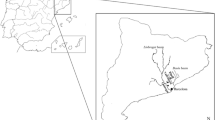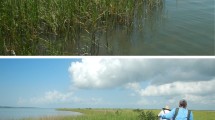Abstract
Insectivorous birds can provide important ecosystem services, including regulating insect populations. The function of insectivorous birds in wetland ecosystems, such as tidal marshes, however, remains largely unexplored. Most studies of top-down interactions between insectivorous birds and herbivorous insects focus on insects in exposed-feeding guilds, but rarely on those in concealed-feeding guilds. In a reed-dominated estuarine tidal marsh, we examined the impacts of insectivorous birds on three groups of insect herbivores with concealed-feeding habits, including scale insects, gall-forming fly larvae, and stem-boring caterpillars. Insectivorous birds attacked 14.0–75.8% of reed shoots infested with scale insects, 13.3–20.7% with gall-forming fly larvae, and 8.0–100.0% with stem-boring caterpillars. Bird predation also significantly changed the abundance of herbivores, reducing scale insects by 36.7–85.9%, gall-forming fly larvae by 33.3–46.0%, and stem-boring caterpillars by 77.0–100.0%. Scale insects and stem-boring caterpillars suffered bird predation during different periods of the growing season. Our study demonstrated significant impacts of bird predation on concealed-feeding insects in a reed-dominant tidal marsh, highlighting the role of insectivorous birds in vegetated wetland ecosystems.



Similar content being viewed by others
References
Adam P (1990) Saltmarsh ecology. Cambridge University Press, Cambridge
Albarbacin MT, Stiling P (2006) Bottom-up and top-down effects on insect herbivores do not vary among sites of different salinity. Ecology 87:2673–2679
Atlegrim O (1989) Exclusion of birds from bilberry stands: impact on insect larval density and damage to the bilberry. Oecologia 79:136–139
Bailey JK, Whitham TG (2003) Interactions among elk, aspen, galling sawflies and insectivorous birds. Oikos 101:127–134
Báldi A (1999) Microclimate and vegetation edge effects in a reedbed in Hungary. Biodiversity and Conservation 8:1697–1706
Day JW, Hall CAS, Kemp WM, Yánez-Arancibia A (1989) Estuarine ecology. Wiley, New York
Denno RE, Peterson MA, Gratton C, Cheng J, Langellotto GA, Huberty AE, Finke DL (2000) Feeding-induced changes in plant quality mediate interspecific competition between sap-feeding herbivores. Ecology 81:1814–1827
Denno RE, Lewis D, Gratton C (2005) Spatial variation in the relative strength of top-down and bottom-up forces: causes and consequences for phytophagous insect populations. Annales Zoologici Fennici 42:295–311
Desender K, Maelfait JP (1999) Diversity and conservation of terrestrial arthropods in tidal marshes along the River Schelde: a gradient analysis. Biological Conservation 87:221–229
Dunson WA, Travis J (1994) Patterns in the evolution of physiological specialization in salt-marsh animals. Estuaries 17:102–110
Fowler AC, Knight RL, George TL, McEwen LC (1991) Effects of avian predation on grasshopper populations in North Dakota grassland. Ecology 72:1775–1781
Gratton C, Denno RF (2003) Seasonal shift from bottom-up to top-down impact in phytophagous insect populations. Oecologia 134:487–495
Greenberg R, Maldonado JE (2006) Diversity and endemism in tidal-marsh vertebrates. Studies in Avian Biology 32:32–53
Greenberg R, Maldonado JE, Droege S, McDonald MV (2006) Tidal marshes: a global perspective on the evolution and conservation of their terrestrial vertebrates. BioScience 56:675–685
Gunnarsson B, Heyman E, Vowles T (2009) Bird predation effects on bush canopy arthropods in suburban forests. Forest Ecology and Management 257:619–627
Haslam SM (1972) Phragmites communis Trin. (Arundo Phragmites L., Phragmites australis (CAV.) Trin. Ex Steudel). Journal of Ecology 60:585–610
Holmes RT, Schultz JC, Nothnagle P (1979) Bird predation on forest insects: an exclosure experiment. Science 206:462–463
Hooks CR, Pandey RP, Johnson MW (2003) Impact of avian and arthropod predation on lepidopteran caterpillar densities and plant productivity in an ephemeral agroecosystem. Ecological Entomology 28:522–532
Kaneko S (2005a) Abundances of five parasitoids attacking the scale insect Nipponaclerda biwakoensis on morphologically changed reed shoots due to damage by a stem-boring caterpillar. Ecological Research 20:555–561
Kaneko S (2005b) Seasonal population changes of five parasitoids attacking the scale insect Nipponaclerda biwakoensis on the common reed, with special reference to predation by wintering birds. Entomology Science 8:323–329
Koh LP (2008) Birds defend oil palms from herbivorous insects. Ecological Applications 18:821–825
Low C, Connor EF (2003) Birds have no impact on folivorous insect guilds on a montane willow. Oikos 103:579–589
Martínez-Vilalta J, Bertolero A, Bigas D, Paquet J, Martínez-Vilalta A (2002) Habitat selection of passerine birds nesting in the Ebro delta reedbeds (NE Spain): management implications. Wetlands 22:318–325
Matessi G, Griggio M, Pilastro A (2002) The geographical distribution of populations of the large-billed subspecies of reed bunting matches that of its main winter food. Biological Journal of the Linnean Society 75:21–25
Poulin B, LeFebvre G (2002) Effect of winter cutting on the passerine breeding assemblage in rench Mediterranean reedbeds. Biodiversity and Conservation 11:1567–1581
Poulin B, Lefebvre G, Mauchamp A (2002) Habitat requirements of passerines and reedbed management in southern France. Biological Conservation 107:315–325
Rand TA (2002) Variation in insect herbivory across a salt marsh tidal gradient influences plant survival and distribution. Oecologia 132:549–558
Rank M (1989) Eye-browed parrotbill. Orient Bird Club Bulletin 10:22–27
Sala NM, Bertness D, Silliman BR (2008) The dynamics of bottom-up and top-down control in a New England salt marsh. Oikos 117:1050–1056
Schmidt MH, Lefebvre G, Poulin B, Tscharntke T (2005) Reed cutting affects arthropod communities, potentially reducing food for passerine birds. Biological Conservation 21:157–166
Sekercioglu CH (2006) Increasing awareness of avian ecological function. Trends in Ecology and Evolution 21:464–471
Shen BY, Xia BC, Gu BY, Yan TM, Li YS, Cao Q (1995) Investigations on the bionomics and ecological control of Nipponaclerda biwakoensis. Plant Protection 3:15–17, in Chinese, with English abstract
Sipura M (1999) Tritrophic interactions: willows, herbivorous insects and insectivorous birds. Oecologia 121:537–545
Tscharntke T (1988) Variability of the grass Phragmites australis in relation to the behaviour and mortality of the gall-inducing midge Giraudiella inclusa (Diptera, Cecidomyiidae). Oecologia 76:504–512
Tscharntke T (1989) Attack by a stem-boring moth increases susceptibility of Phragmites australis to gall-making by a midge: mechanisms and effects on midge population dynamics. Oikos 55:93–100
Tscharntke T (1992) Cascade effects among four trophic levels: bird predation on galls affects density-dependent parasitism. Ecology 73:1689–1698
Tscharntke T (1999) Insects on common reed (Phragmites australis): community structure and the impact of herbivory on shoot growth. Aquatic Botany 64:399–410
Valkama E, Lyytinen S, Koricheva J (2008) The impact of reed management on wildlife: a meta-analytical review of European studies. Biological Conservation 141:364–374
Van Bael SA, Brawn JD (2005) The direct and indirect effects of insectivory by birds in two contrasting Neotropical forests. Oecologia 145:658–668
Van Bael SA, Philpott SM, Greenberg R, Bichier P, Barber NA, Mooney KA, Gruner DS (2008) Birds as predators in tropical agroforestry systems. Ecology 89:928–934
Vince SW, Valiela I, Teal JM (1981) An experimental study of the structure of herbivorous insect communities in a salt marsh. Ecology 62:1662–1678
Wang ZD, You LS, Xiong SL (1989) An iconography of pests and natural enemies of Amur silvergrass and reed. China Light Industry Press, Beijing, in Chinese, with English abstract
Whelan CJ, Wenny DG, Marquis RJ (2008) Ecosystem services provided by birds. Annals of the New York Academy of Sciences 1134:25–60
Xiong LH, Wu X, Gao W, Zhou J, Lu JJ (2007) Impact of reed cutting on foraging of Reed Parrotbill Paradoxornis heudei. Chinese Journal of Zoology 42:41–47, in Chinese, with English abstract
You LS, Xiong SL, Huang AK, Huang YK, Chen H (1994) Studies on Phragmataecia Castaneae, the giant borer of reed in Dongting Lake region. Acta Entomologica Sinica 37:190–195, in Chinese, with English abstract
Acknowledgments
We thank Wei Gao, Chao-Xiong Gao, Jin-Gang Wang, and the staff of Chongxi Wetland Research Center (CWRC) for their assistance in the field. We especially thank Ruthmarie H. Mitsch, The Ohio State University, for language help, and two anonymous reviewers and the editor for valuable comments. The research was financially supported by Shanghai Science & Technology Administration (No.06DZ12301, No. 05DZ12008 and 04DZ12049).
Author information
Authors and Affiliations
Corresponding author
Rights and permissions
About this article
Cite this article
Xiong, LH., Wu, X. & Lu, JJ. Bird Predation on Concealed Insects in a Reed-dominated Estuarine Tidal Marsh. Wetlands 30, 1203–1211 (2010). https://doi.org/10.1007/s13157-010-0104-0
Received:
Accepted:
Published:
Issue Date:
DOI: https://doi.org/10.1007/s13157-010-0104-0




